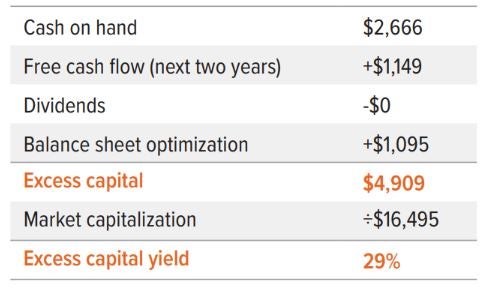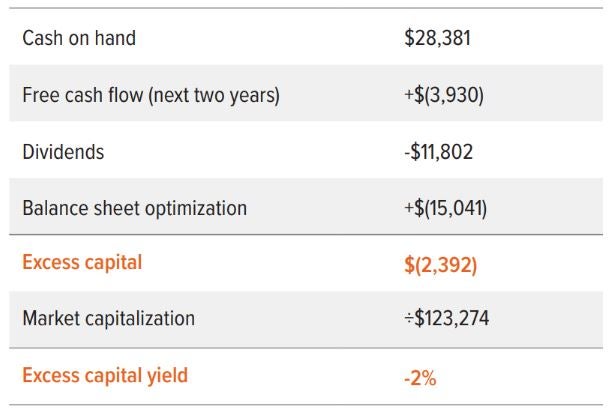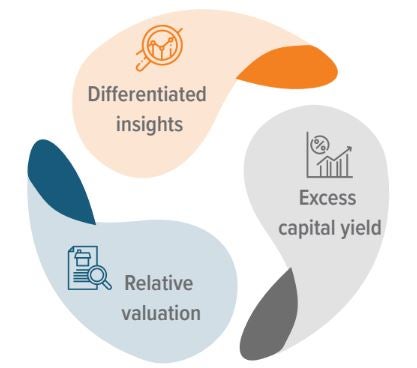
Assessing stocks through the lens of excess capital formation can help investors avoid value traps and identify high-quality stocks that tend to look less attractive based on traditional metrics.
What draws investors to value stocks? Maybe it’s the allure of a low price-to-earnings (P/E) ratio or a nice dividend. However, these indicators only offer a limited snapshot of a stock’s true value and can lead to overlooked gems and mistakenly glorified stocks.
Our excess capital yield (ECY) framework provides a more sophisticated, holistic lens through which to view value opportunities. Below are two examples of how ECY can uncover hidden value in companies with distinctive profiles, adding a new dimension to traditional metrics.
Value redefined
While low-multiple stocks are typically associated with value investing, stocks that trade above the market multiple can also represent valuable opportunities, even if they initially appear expensive.
The stock of “ABC,” which operates a photo-sharing, pinboard-style website, was trading at a P/E of 36x—almost double the market’s average of 19x. Even after factoring in projected growth, the stock seemed overpriced, especially considering that it didn’t pay a dividend. Accordingly, the stock was held by only 3% of value managers, despite its inclusion in the Russell 1000 Value benchmark.
When we applied ECY analysis, a different view unfolded, revealing an attractive investment opportunity (Exhibit 1).

Source: FactSet, Voya IM. Numbers may not foot due to rounding. Values are millions of USD. For illustrative purposes only.
An ECY of 29% revealed that ABC had substantial dry powder for enhancing shareholder value. While traditional metrics might not classify it as a value stock, we perceived its significant cash reserves, strong cash flow generation and relatively underleveraged balance sheet as strong indicators of its true value.
Further qualitative analysis pointed towards positive potential catalysts. The company had recently hired new management focused on steering the platform towards profitability. This strategic shift, combined with the company’s excess capital, presented a compelling opportunity that had been overlooked and made it an attractive and underowned option.
Value reassessed
Sometimes stocks are cheap for a reason. Stock “XYZ,” which designs, manufactures and sells computer products and technologies, was trading close to its book value and below the market average at a P/E of 16x. It also paid a hefty 4.9% dividend yield. These characteristics fit the traditional mold of an attractive value investment, and 85% of value managers owned this stock, which also had a meaningful presence in the benchmark.
But a deeper look unearthed warning signs (Exhibit 2).
XYZ not only featured a -2% excess capital yield, but it also displayed poor fundamental characteristics. At the time, it was lagging behind other chipmakers in the competitive artificial intelligence semiconductor space and was losing market share.

Source: FactSet, Voya IM. Numbers may not foot due to rounding. Values are millions of USD. For illustrative purposes only
Defining quality
These examples illustrate how ECY aids Voya in choosing or steering clear of certain stocks. However, it’s not the sole factor in our decision-making process. We also evaluate relative valuation metrics and incorporate unique insights from our investment team (Exhibit 3).

Source: Voya IM.
1. ECY is grounded in tangible inputs.
Unlike earnings, which can be manipulated, cash on hand, dividends and balance sheet optimization (debt to capital ratio) are actual figures. The only estimated element is free cash flow, which is based on a consensus forecast for the next two years and can be subject to overestimations or underestimations.
We often field questions about the role of dividends in our calculations. If a company reduces its dividend—a move generally seen as a negative indicator—ECY actually improves. This is where our team’s insights come into play. For instance, when Differentiated insights Relative valuation Excess capital yield Source: Voya IM. Company XYZ reduced its dividend, this positively impacted its ECY. However, our analysts delved deeper to understand the underlying reasons and uncovered potential negative catalysts.
2. Relative valuation measures help target attractive companies.
Rather than merely using valuation metrics to identify “cheap” stocks, ECY employs relative multiple deviation and proprietary stock selection models to refine our list of potential investments.
3. Insights from our investment professionals bring ECY from theory to practice.
Our analysts start with ECY but go further to provide insights into how a company’s management might use it. For example, a company might have high or increasing excess capital, but that doesn’t guarantee effective stewardship. If a company’s management has a history of capital destruction, such as making non-accretive acquisitions, the impact of ECY could be diminished.
Additionally, a company that is underleveraged yet conservative might not access its balance sheet flexibility. In such cases, our analysts might reduce or eliminate the optimization benefit from our evaluation. Conversely, if an overleveraged company has demonstrated superior debt management and has benefited from its balance sheet, our analysts might assess the optimization more favorably.
Complementary value investing
Zigging while others zag offers a differentiated twist on traditional value investing. We believe that incorporating our value strategy into an asset allocation presents a low-correlation opportunity to gain exposure to distinctive, high-quality value stocks. This approach not only diversifies but also enhances the overall value allocation.
A note about risk
The principal risks are generally those attributable to investing in stocks and related derivative instruments. Holdings are subject to market, issuer and other risks, and their values may fluctuate. Market risk is the risk that securities or other instruments may decline in value due to factors affecting the securities markets or particular industries. Issuer risk is the risk that the value of a security or instrument may decline for reasons specific to the issuer, such as changes in its financial condition.


